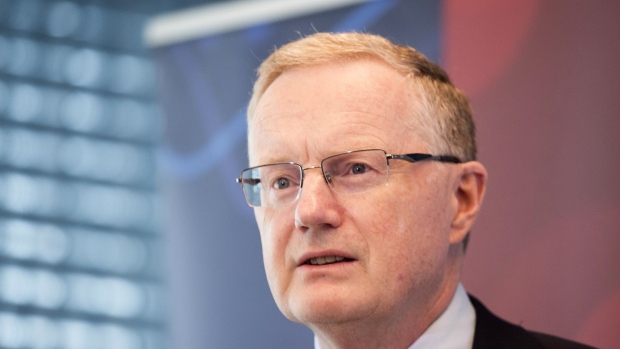Oct 4, 2022
RBA Surprises Market With Quarter-Point Hike, Currency Tumbles
, Bloomberg News

(Bloomberg) -- Australia staked out an outlier position among major central banks, becoming the first to break with outsized interest-rate increases as it delivered a quarter percentage-point move.
Bond yields and the currency tumbled as the Reserve Bank raised the cash rate to 2.6% -- a result predicted by only a quarter of 28 economists surveyed. Governor Philip Lowe reinforced his commitment to tightening even as he acted on signals last month of a slower pace of increase.
“The RBA has bucked the trend of the other major central banks,” said Gareth Aird at Commonwealth Bank of Australia, who predicted today’s outcome. “The cash rate now sits in restrictive territory.”
Australian policymakers are mindful that their household sector is among the world’s most-indebted and the prevalence of variable mortgage rates means hikes are particularly potent. Lowe’s decision prompted the biggest intraday drop in three-year government bond yields since October 2008, when the RBA cut by 100 basis points heading into the global financial crisis.
The RBA is in the midst of its sharpest policy tightening in a generation as it joins global counterparts in trying to rein in inflation. Yet consumer-price growth hasn’t been as intense as elsewhere and Lowe is trying to navigate a path back to his 2-3% inflation target without crashing the economy.
That contrasts with other central banks including the Federal Reserve that have made crushing inflation their No. 1 priority.
“The cash rate has been increased substantially in a short period of time,” Lowe said in his statement. “The board remains resolute in its determination to return inflation to target and will do what is necessary to achieve that.”
The Australian dollar dropped as much as 1% following the decision, while the benchmark S&P/ASX 200 index advanced 3.8%.
A hawkish Fed and signs Australia’s debt-laden households were coping with rate hikes prompted economists to predict the RBA would deliver a final large increase before reverting to a more normal pace of tightening.
Lowe again highlighted today that the effect of policy comes with a lag.
“The risk behind today’s decision is that it eventually looks more like a detrimental delay, forcing the RBA to ‘chase’ higher than expected inflation and wage prints though a prolonged hiking cycle that stretches into 2023,” said Phil Odonaghoe, Australia economist at Deutsche Bank AG.
The RBA expects inflation will peak around 8% before declining next year. The governor’s decision to downshift the pace of tightening comes ahead of third-quarter inflation data later this month.
Economists see the RBA pausing at a cash rate of 3.35%, while money markets imply a peak of 3.6% by mid-2023, down from about 4% prior to the decision.
What Bloomberg Economics Says...
The “decision to opt for a smaller hike is a sign that the rapid rate hiking cycle may be nearing an end. We think the RBA will deliver another 40 basis points of tightening over coming months.”
-- James McIntyre, economist
To read full note, click here
Diana Mousina, a senior economist at AMP who predicted today’s decision, highlighted that close to 60% of mortgages are on variable rates, while even those fixed are typically on terms of 2-3 years, versus 30 years in the US.
“Australia’s vulnerability to higher interest rates will prevent the RBA from raising the cash rate too far, with less hikes required to slow demand,” said Mousina, who expects the cash rate to peak at 2.85%.
The rapid policy tightening has prompted economists to predict a sharp slowdown in Australia’s A$2.2 trillion ($1.4 trillion) economy in the year ahead. Lowe has acknowledged that policymakers have a narrow path to beat back inflation and bring the economy in to a soft landing.
“The board’s priority is to return inflation to the 2–3% range over time,” he said. “It is seeking to do this while keeping the economy on an even keel. The path to achieving this balance is a narrow one and it is clouded in uncertainty.”
(Adds comment from Deutsche Bank economist in 11th paragraph.)
©2022 Bloomberg L.P.





